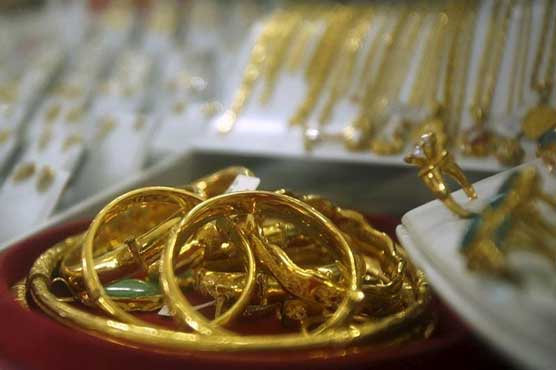Gold price surges Rs 1,900 to Rs 115,000 per tola

The price of 10 gram gold increased by Rs 1,624 and was traded at Rs 98,594
KARACHI (Dunya News) – The price of 24 karat gold increased by Rs 1,900 on Thursday and was traded at Rs 115,000 against its price at Rs 113,100.
Likewise, the price of 10 gram gold increased by Rs 1,624 and was traded at Rs 98,594 against its sale at Rs 96,965, Karachi Sarafa Association reported.
The price of per tola silver increased by Rs 20 and was traded Rs 1320 against its sale at Rs 1,300 while that of 10 gram silver increased by Rs 17.14 and was sold at Rs 1,131.68 against Rs 1,114.54.
The gold prices in the international market increased by US $30 and was traded at US $1956 against US $1,926, the association reported.
Pakistan’s gold reserves rise by 20pc
Pakistan s gold reserves increased by 20 percent during the fiscal year 2018-19 to $3.04 billion as compared to the preceding year s reserves of $2.534 billion, the Asian Development Bank (ADB) said in a report.
The annual statistical report “Key Indicators for Asia and the Pacific 2020”, presents a comprehensive set of economic, financial, social, and environmental indicators, including for the Sustainable Development Goals (SDGs), for ADB’s 49 regional members covering the years from 2000 to 2019.
A key statistic in the report highlights how the region has become the biggest contributor to global gross domestic product (GDP), reaching a 34.9% share in 2019 from 26.3% in 2000.
“The Asia and Pacific region has made tremendous development progress over the last two decades, becoming the biggest contributor to global GDP while lifting millions of people out of poverty,” said ADB Chief Economist Yasuyuki Sawada. “Timely and accurate data enable us to take stock of this progress and areas that require further improvement. Wide access to data, especially amid the coronavirus disease (COVID-19) pandemic, will continue to contribute to the region’s progress on the path to more inclusive and sustainable development.”
Key Indicators 2020 highlights the expanding influence of Asia and the Pacific in global investment and trade. The region’s economies received more than one-third of total global direct investment in 2019, while the region’s global export share increased to 36.5% in 2019 from 28.4% in 2000.
More than half of the reporting economies in the region recorded a GDP growth rate of 4% or higher in 2019. These gains are threatened, however, by the COVID-19 pandemic, with unemployment rising and income falling as lockdowns cause steep reductions in business operations and people’s activities in general.
The report includes a special supplement looking at how the granularity of poverty estimates can be enhanced by integrating household surveys and censuses with data extracted from satellite imagery.
The report identifies practical considerations and technical requirements for this novel approach to mapping the spatial distribution of poverty, while outlining the investments required by national statistics offices to fully capitalize on the benefits of incorporating innovative data sources into conventional work programs.
Key Indicators 2020 also presents updates on SDG indicators in Asia and the Pacific, regional trends and tables, including indicators across eight themes—people; economy and output; money, finance, and prices; globalization; transport and communications; energy and electricity; environment; and government and governance.
The Key Indicators Database, first launched in September 2019, offers access to more than 1,100 statistical indicators from the year 2000 onwards in a user-friendly and accessible interface.

